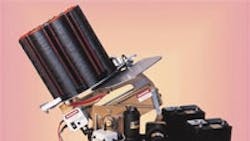Most overrunning clutches are one of three types: roller ramp, sprag, or wrap spring. A relatively new device, called the wedge ramp clutch, incorporates the major benefits of these well-established types. Introduced several years ago, wedge ramp clutches are now available from several European and U.S. companies.
Here’s how the three original clutches work, along with their major benefits. Later, we’ll see how the new clutch stacks up.
A roller ramp clutch contains a cylindrical outer member , dowel-shaped rollers, and an inner member with a flat contact surface for each roller, Figure 1. Light spring force keeps each roller positioned in a wedge-shaped pocket formed by the flat surface of the inner member and cylindrical surface of the outer member.
Friction between the roller and these two contacting surfaces makes each roller wedge tightly when the inner member rotates in the driving direction, thus locking the inner and outer members together, or engaging the clutch. When an external source drives the outer member in this same direction and the inner member is running slower or stationary, friction causes the roller to move against the spring force and into the larger part of the pocket, disengaging the clutch.
The roller ramp clutch typically lasts longer than the other types. When worn out, it fails by the normally preferred method of slipping, rather than locking up (which can damage drive components). In most cases, maintenance workers can easily replace its components in the field. Some versions, however, require careful disassembly to prevent the rollers and springs from falling out.
A sprag clutch, Figure 2, operates similarly, but both the inner and outer members are cylindrical and it has irregularly shaped sprags that tip and wedge between the members in one direction only.
Sprag clutches have higher torque ratings and overrunning speed capability than roller ramp clutches. But the sprags take up a large amount of radial space, which limits bore sizes. As a result, torque capacity of the shaft is less than that of the clutch. Also, some types can lock up under load when the sprags are worn.
A wrap spring clutch differs from the two previous types in that it has a helical spring that tightens on a cylindrical sleeve to transmit torque in one direction. Wrap spring clutches cost less than the other types, but are limited to lightduty, low-speed applications.
Wedge ramp
The wedge ramp clutch incorporates the major benefits of the roller ramp, sprag, and wrap spring types: high torque and overrunning speed capability, easy field repair, and low cost.
• Torque. The new clutch has an outer member with flat contact surfaces, cylindrical rollers, and an inner member with a cylindrical OD, Figure 3. The outer member contains the rollers, not the inner member as with a roller ramp unit. Its larger circumference, combined with compact springs, enables more rollers to be used, which boosts the torque capacity.
Compared to a sprag clutch, the inner member has space for a larger bore and keyway so that the torque capacity of the shaft more closely matches that of the clutch.
Overload factor. Overloads due to excessive torque cause slight deflections of the mating components in roller ramp clutches, which affects the wedge angle, Figure 1, and may reduce torque capacity. Tests have shown that the torque capacity of wedge ramp clutches, which use high strength material to minimize these deflections, increases slightly due to overload.
• Speed. The rollers rotate as a subassembly with the outer member, and they lift off the inner member when the outer member overruns at high speeds. This reduces friction, heat generation, and wear, and lets the unit operate at speeds up to 3,000 rpm.
Continue on page 2
• Field repair. Both the rollers and springs are contained in a housing subassembly for convenient handling, and they can be easily replaced by sliding them axially out of the housing.
In most clutches, the inner member wears faster than the outer because it is subject to higher loads. In the wedge ramp clutch, therefore, the first member to need replacement due to wear is the less expensive inner member, not the outer member containing the machined flats.
• Cost. Finishing of the outer housing surfaces, including the flats, is done by broaching. This process makes the housing less expensive.
Versatility
The wedge ramp design is adaptable to several configurations such as clutches, clutch-couplings, backstops, bi-directional overrunning clutches, and even single-revolution clutches. Also, the device can be furnished as a light-duty, one-way-bearing- type clutch, or its components can be furnished as a subassembly that the user installs in a housing of its own manufacture.
Skip Gibbs is engineering product manager, The Hilliard Corp., Elmira, N.Y.
